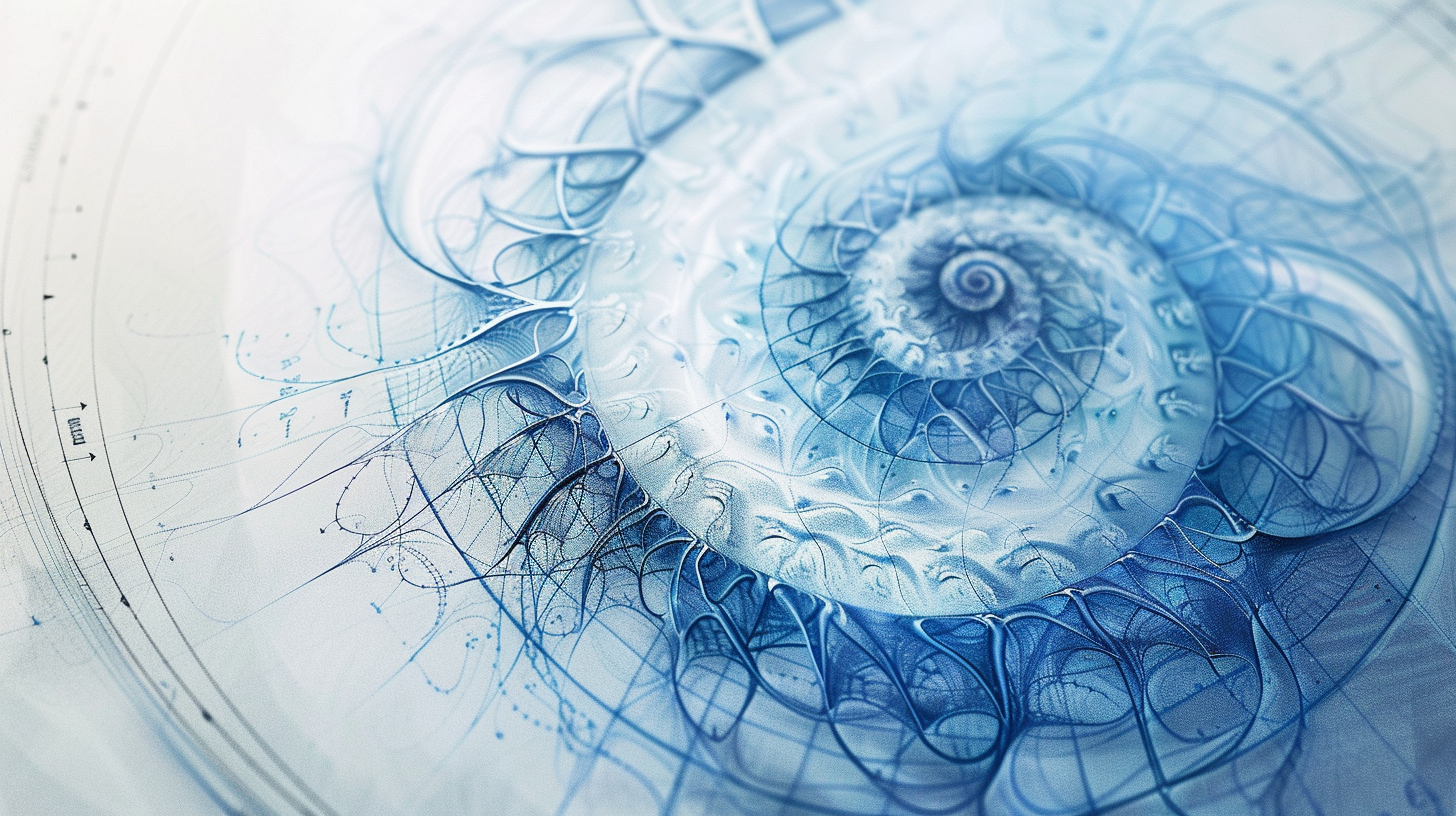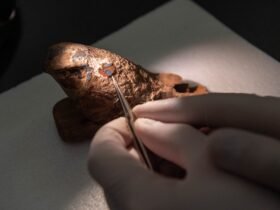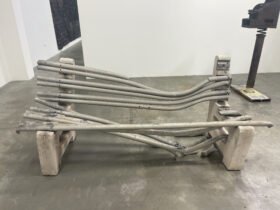The Shape: Allure of the Spiral
How important is the shape of the first tattoo? Well, the first time I encountered mine, the Fibonacci motif, it was merely a stencil, a delicate outline on thin, translucent paper. Yet, from the moment I laid eyes on it, I was captivated. The spiral, starting from a small point and expanding outwards in a precise and beautiful ratio, seemed to echo the very patterns of the universe. There was something inherently mystical about it, something that drew me in and whispered secrets of the cosmos.
As I studied the stencil, the perfect symmetry and harmony of the shape began to take hold of me. It wasn’t just a pattern; it was a reflection of nature’s design, present in the swirling galaxies, the unfurling fern fronds, and the delicate shells washed up on the shore. The Fibonacci sequence, a series of numbers where each is the sum of the two preceding ones, translated into this spiral, symbolized a deeper order in the seemingly chaotic world.
I could feel an inexplicable connection to it, as if the spiral was a part of me, or perhaps I was a part of it. The more I stared at the pattern, the more I felt its magnetic pull. It wasn’t just the aesthetic beauty that fascinated me; it was the profound meaning behind it. The Fibonacci spiral was nature’s code, a mathematical formula embedded in the fabric of reality. It spoke of growth, evolution, and the infinite possibilities of life.

I knew then that this motif was more than just a beautiful tattoo design – it was a talisman of sorts, a reminder of the interconnectedness of all things. The decision to have it inked on my thigh was almost instantaneous. I wanted this symbol to be a permanent part of me, a testament to the harmony and balance I sought in my life.
The day I went to the tattoo studio, I carried the stencil with a sense of reverence. The artist, a patient and meticulous craftsman, understood the significance of the design. As the needle buzzed to life, I braced myself, feeling a mix of excitement and trepidation. The first touch of the needle was sharp, a sudden jolt, but as the artist began tracing the intricate spiral, the pain faded into a meditative rhythm.
With each passing moment, I felt the Fibonacci spiral becoming a part of my being, etched into my skin and soul. The process was both cathartic and transformative. As the artist worked, I reflected on the natural wonders that shared this pattern – the spirals in sunflower heads, the whorls of a pinecone, the vastness of hurricanes, and the grace of a nautilus shell.
By the time the tattoo was complete, I felt a profound sense of fulfillment. The Fibonacci spiral on my thigh was more than ink on skin; it was a symbol of the universal patterns that connected all living things. It was a reminder of the beauty of mathematics, the elegance of nature, and the infinite possibilities that lay ahead.
In the days and weeks that followed, the tattoo became a focal point for my thoughts and reflections. It served as a constant reminder of the natural order and the hidden patterns that governed our lives. Every time I looked at it, I felt a sense of peace and connection to something much greater than myself. The Fibonacci spiral, once just a captivating design on a stencil, had become a part of my identity, a symbol of the intricate dance of life that I carried with me always. Choosing the right tattoo design had been a crucial step in this journey, as the process of choosing a tattoo is deeply personal and reflective of one’s inner world.
The Decision and Placement
Choosing to get a tattoo is never a decision made lightly, and selecting the right design is only half of the journey. The placement of the tattoo is equally significant, as it dictates how much of oneself is revealed to the world. For me, the Fibonacci spiral had an immediate and natural attraction. It caught me like a drug, an irresistible pull that demanded to be a part of me. However, the decision on where to place it on my body was a more intricate deliberation.
The thigh, I decided, was the perfect spot for my first tattoo. It was a place I could easily conceal, showing it only to those close to me, those who truly understood my journey and my story. The thigh offered a private canvas, a secret that I could share selectively. This choice reflected my initial hesitation and the desire to keep this deeply personal symbol close to my heart, away from the prying eyes of the world.
Tattoos, I realized, are more than just ink on skin; they are a form of storytelling, a way to convey personal narratives and beliefs. The placement of a tattoo can speak volumes about the person wearing it. For some, like myself, a more concealed location such as the thigh, ribs, or back might be chosen out of a desire for privacy or as a means of keeping the symbol intimate. It’s a personal treasure, revealed only to those who are trusted.

For others, the decision might be quite the opposite. A tattoo on the forearm, wrist, or even the neck signifies a bold statement, a willingness to share a piece of their story with everyone they encounter. These individuals wear their tattoos with pride, using their skin as a canvas to display their identity to the world. It’s a declaration of self that they are eager to share openly, a visual representation of their journey and beliefs.
Consider the lower back, often chosen for its blend of visibility and discretion. A tattoo here can be easily hidden or revealed, allowing the bearer control over who gets to see this part of their story. This placement is popular for those who enjoy the duality of public and private expression.
Then there are those who choose the chest or the upper arm, areas that can be both covered and revealed depending on the occasion. These placements allow for a versatile expression, where the tattoo can remain a personal secret in professional settings and a bold statement in more casual environments.
The ankle and foot are also chosen by many for their tattoos, often symbolizing something that grounds them or represents their journey through life. These tattoos can be small and intricate, easily hidden by shoes or socks, yet visible enough to make a personal statement when desired.
Each placement is a carefully considered decision, a balance between personal expression and public perception. My choice of the thigh was a reflection of my initial caution, a step into the world of tattoos that I could control and reveal on my terms. It was a way to embrace the allure of the Fibonacci spiral while keeping it close, a part of my personal story that I could share selectively.
In the end, the placement of a tattoo is as meaningful as the design itself. It’s a personal choice that reflects one’s relationship with their body and their willingness to share their story with the world. For me, the thigh was the perfect starting point, a place where I could nurture this new addition to my identity, revealing it slowly and thoughtfully to those who mattered most.
The Ritual of Ink
The decision to get a tattoo had been made, and the placement carefully chosen. However, the next step – actually getting inked – was fraught with anxiety. My fear of needles was profound, a phobia that had followed me since childhood. The thought of a needle piercing my skin repeatedly was terrifying. But beyond the pain, there were other fears lurking in my mind: the cleanliness of the shop, the hygiene practices of the tattoo artist, and the overall safety of the process.
Finding the right tattoo shop became a quest in itself. I spent countless hours researching, reading reviews, and seeking recommendations. I was looking for a place with an impeccable reputation, where professionalism and hygiene were as important as artistic skill. This was more than just about enduring pain; it was about entrusting someone with my health and well-being.

Finally, after much deliberation, I found a shop that stood out. Its reputation for cleanliness and meticulous care in both artistry and hygiene was unmatched. On the day of my appointment, I walked in with a mix of excitement and trepidation. The studio was a sanctuary of calm, with walls adorned with vibrant artwork and the subtle hum of the tattoo machines creating an oddly soothing background noise.
The artist greeted me warmly, his demeanor calm and reassuring. He walked me through the entire process, answering my questions and addressing my fears with patience. He showed me the sterile, single-use needles still in their packaging, and I watched as he meticulously washed his hands and put on a fresh pair of gloves. Every step was taken with care, every piece of equipment spotless and sterile. This level of professionalism was comforting, and it eased a significant part of my anxiety.
As I settled into the chair, the stencil of the Fibonacci spiral already in place on my thigh, my heart raced. The moment of truth had arrived. The artist’s calm voice guided me through breathing exercises, encouraging me to relax. Then, with the hum of the machine, the needle made its first contact with my skin. The sensation was sharp and stinging at first, but as he began to trace the intricate spiral, it transformed into a rhythmic buzz, almost meditative.
The pain, I realized, was not as unbearable as I had feared. It was more of a persistent discomfort, a reminder that something transformative was happening. With each pass of the needle, the Fibonacci spiral began to take shape, its perfect curves and lines coming to life on my skin. The process was slow and deliberate, each stroke of the needle precise and intentional.
As the session continued, I found myself entering a state of deep reflection. The pain became secondary to the significance of the moment. This was a ritual, a rite of passage, marking a profound personal journey. The Fibonacci spiral, a symbol of natural order and beauty, was becoming a part of me, etched into my skin with care and precision.
The artist’s skill and professionalism shone through every aspect of the process. He worked with an artist’s passion and a surgeon’s precision, ensuring that each line was perfect, each curve flawless. His commitment to hygiene and safety was evident, and it reinforced my confidence in my decision.
When the session finally ended, I looked down at my thigh and saw the completed tattoo. The Fibonacci spiral was now a part of me, a beautiful and permanent reminder of my journey. The fear and anxiety I had felt melted away, replaced by a sense of accomplishment and pride.

The ritual of ink had been more than just a physical experience; it was an emotional and spiritual journey. It taught me about trust, courage, and the importance of choosing the right people to accompany you on significant life journeys. The tattoo artist, with his skill and care, had not only given me a beautiful piece of art but also a profound sense of fulfillment and peace.
This chapter of my life, marked by the Fibonacci spiral on my thigh, was a testament to overcoming fear and embracing transformation. The ritual of ink had become a part of my story, a vibrant thread woven into the tapestry of my life.
The Importance of the Stencil
The stencil – also called tattoo flash – of the Fibonacci spiral was the catalyst that led me to get my first tattoo. It wasn’t just a guide; it was a piece of art that captured my imagination and drew me into the world of tattoos. Seeing the design on paper, perfectly proportioned and ready to be transferred onto my skin, gave me the confidence to move forward with my decision.
As I delved deeper into the tattooing process, I began to appreciate just how crucial the stencil is, especially for larger and more intricate designs. A good tattoo artist might have the skill to work freehand, but the stencil serves as a blueprint that ensures precision and consistency. It’s a foundational step that can significantly impact the final outcome of the tattoo.
A stencil provides a clear and accurate representation of the design, allowing both the artist and the client to visualize the end result before the needle ever touches the skin. This is particularly important for complex patterns like the Fibonacci spiral, where even a slight deviation can disrupt the harmony and balance of the design. The stencil ensures that each line and curve is placed exactly where it should be, maintaining the integrity of the original artwork.

Many people underestimate the value of the stencil, thinking it’s merely a preliminary step that can be skipped. However, the stencil is an essential tool that can only enhance the tattooing process. It’s a safety net that prevents mistakes and ensures the tattoo lives up to the client’s expectations. For me, seeing the Fibonacci spiral as a stencil was a moment of clarity. It confirmed that this was the design I wanted to carry with me for the rest of my life.
Moreover, the stencil provides a sense of security for the client. Knowing that the artist will follow a precise outline can alleviate some of the anxiety associated with getting a tattoo. It’s a visual confirmation that the design you fell in love with on paper will be faithfully replicated on your skin. This reassurance is invaluable, especially for those new to the tattooing experience.
A good tattoo artist understands the importance of the stencil and uses it to elevate their work. Even the most talented artists can benefit from this guiding outline, ensuring their creations are as accurate and beautiful as possible. It’s a collaboration between the artist’s skill and the client’s vision, brought to life through the stencil.
In the end, the stencil is more than just an outline; it’s a commitment to the design and a promise of what’s to come. For those considering a tattoo, embracing the stencil can make the difference between hesitation and confidence. It’s a tangible step towards turning a dream design into a permanent piece of art. The stencil is a crucial part of the tattooing ritual, a blueprint that transforms inspiration into reality, one line at a time.
Choosing the Right Colors
When it came to selecting the color for my Fibonacci spiral tattoo, the decision was surprisingly straightforward. The design I fell in love with was rendered in a light blue hue, a color that resonated with me deeply. There was something serene and calming about it, and I knew instantly that I didn’t want to change a thing. The light blue shade perfectly complemented the elegant simplicity of the Fibonacci pattern, and for me, it was the ideal choice.
However, choosing the right colors for a tattoo is not always so simple for everyone. Color selection can be an intricate process, influenced by a variety of factors, including personal preferences, symbolism, and even physical characteristics. For some, the decision might revolve around finding a color that harmonizes with their natural features, such as eye color. This approach can create a cohesive and aesthetically pleasing look that enhances the tattoo’s overall impact.

While the idea of matching a tattoo color to one’s eyes might seem unconventional, it’s a consideration for some. For instance, someone with striking green eyes might choose shades of emerald or jade to accentuate their natural beauty. Similarly, blue-eyed individuals might opt for various shades of blue, from deep navy to vibrant turquoise, to create a visual harmony.
Beyond physical attributes, the theme and symbolism of the tattoo often play a significant role in color choice. A design rooted in nature, like flowers or animals, might call for earth tones and natural hues. Conversely, a tattoo inspired by fantasy or abstract art could embrace bold, vibrant colors that convey a sense of whimsy and creativity. The colors chosen can enhance the meaning and emotional resonance of the tattoo, making it a more personal and impactful piece.
Interestingly, some people choose colors based on their current mood or emotional state. This approach, while deeply personal, can be a double-edged sword. Emotions are fleeting, but tattoos are permanent. A color that feels right in a moment of happiness or sorrow might not hold the same appeal years down the line. It’s essential to consider the long-term significance of the chosen colors and how they will be perceived in the future.
For those unsure about which colors to choose, consulting with a skilled tattoo artist can provide valuable insights. Tattoo artists have a keen eye for color theory and can offer suggestions that align with the design, the client’s skin tone, and the desired aesthetic. They can help balance personal preferences with practical considerations, ensuring the final result is both beautiful and meaningful.
In my case, the light blue color was a perfect fit. It reflected a sense of calm and clarity that resonated with me, and it beautifully complemented the intricate lines of the Fibonacci spiral. The simplicity of my choice underscored the elegance of the design, making it a timeless addition to my skin.
Ultimately, choosing the right colors for a tattoo is a deeply personal decision. It’s an opportunity to infuse the design with additional layers of meaning and beauty. Whether it’s a color that matches one’s eyes, reflects a significant theme, or simply feels right in the moment, the choice should resonate with the individual and enhance the overall tattoo experience. Tattoos are lifelong companions, and the colors we choose are part of the story they tell – a vibrant testament to who we are and what we cherish.

The Healing Process
The moment the tattoo needle lifted off my skin for the last time, I felt a mix of relief and accomplishment. The inking of the Fibonacci spiral design was now a permanent part of me, beautifully etched into my thigh. However, the journey was far from over. The healing process, as I soon discovered, was an ordeal in its own right – a test of patience, resilience, and care.
Initially, my new tattoo burned and throbbed, a raw reminder of the fresh ink beneath my skin. The area was sensitive to the touch, and every slight movement sent a wave of discomfort through my body. The pain was more than just physical; it was an incessant, gnawing sensation that made even the simplest tasks feel burdensome. Despite my excitement, the reality of the healing process was a stark contrast to the initial euphoria.
The first few days were particularly challenging. The skin around the tattoo was inflamed and tender, and keeping it clean and moisturized became a meticulous ritual. I followed the aftercare instructions to the letter, using mild soap and applying a thin layer of ointment to keep the area hydrated. Still, the healing felt agonizingly slow, each day dragging on with little relief in sight.
As time passed, the tattoo began to scab and peel, revealing patches of dry, flaky skin. This stage was perhaps the most difficult to endure. The itching was relentless, a constant battle between the urge to scratch and the knowledge that doing so could damage the delicate healing process. I had to remind myself repeatedly that this discomfort was temporary, a necessary step towards the final, healed tattoo.
Amidst the physical discomfort, there was also a lingering fear: What if something went wrong? The risk of infection or skin disease was always in the back of my mind. I was vigilant about cleanliness, avoiding any potential contaminants that could jeopardize the healing tattoo. However, the possibility of an adverse reaction or infection was a shadow that loomed over the entire process.
Even with the best care, there’s always a chance that complications can arise. Skin diseases, allergic reactions, or infections can occur if proper hygiene isn’t maintained. Redness, excessive swelling, or discharge are warning signs that should never be ignored. Seeking medical advice promptly can prevent minor issues from becoming serious problems. The fear of these potential complications added to the overall stress of the healing period.

Another source of anxiety was the uncertainty of how the tattoo would look once fully healed. Tattoos often look their worst during the healing phase – dull, flaky, and uneven. The vibrant colors and sharp lines of the fresh ink can become muted and distorted as the skin heals. There was an ever-present worry that the final result might not live up to my expectations, that the beautiful Fibonacci spiral might lose its luster and clarity.
Despite these fears, I found solace in the support of my tattoo artist and fellow tattoo enthusiasts. They reassured me that what I was experiencing was normal and that patience was crucial. Healing, they reminded me, is a process that requires time and care. The discomfort and uncertainty were temporary, and the reward – a beautifully healed tattoo – was worth the wait.
As the weeks passed, the burning sensation subsided, and the sensitivity diminished. The scabs gradually fell away, and the flaky skin was replaced with a smoother, more resilient layer. The tattoo began to reveal its true form, the colors and lines regaining their vibrancy and precision. It was a slow but steady transformation, a testament to the body’s remarkable ability to heal.
By the time the healing process was complete, my tattoo looked even better than I had hoped. The Fibonacci spiral, with its light blue hue, stood out beautifully against my skin. The journey had been arduous, but the end result was a permanent piece of art that I would carry with pride.
The healing process, though painful and fraught with challenges, is an integral part of getting a tattoo. It’s a period of transition, where the body works to integrate the new ink into its fabric. The discomfort and fears are temporary, but the tattoo – and the story it tells – lasts a lifetime. Through patience, care, and a bit of resilience, the healing process transforms a fresh tattoo into a permanent, cherished part of oneself.
In Doubt’s Shadow
The decision to get a tattoo is often accompanied by a sense of excitement and anticipation, but once the ink is on the skin, doubts can begin to creep in. These doubts cast a shadow over the initial joy, turning what should be a celebration of self-expression into a source of anxiety and fear. Two of the biggest fears that emerge are the worry that the tattoo may not look good and the concern that others – friends, family, or even strangers – may not like it.
The first and perhaps most personal fear is that the tattoo might not meet your expectations once it is on your skin. The design that looked perfect on paper might not translate as beautifully when inked. The placement might seem off, the colors might not pop as expected, or the intricate details might get lost. These fears can be paralyzing, especially after investing so much thought, time, and money into the decision.
When faced with a tattoo that doesn’t live up to expectations, there is a solution: the cover-up tattoo. A well-executed cover-up can transform a regrettable piece into something beautiful and meaningful. It offers a second chance, a new opportunity to make a better choice. However, cover-ups typically require a larger design to effectively obscure the original tattoo, and often a different theme is necessary to achieve the desired result. This can be a daunting prospect, as it means committing to even more ink and a new design concept.

But cover-ups are not always a perfect fix. If the cover-up tattoo also fails to satisfy, or if the original tattoo is too dark or large to be effectively covered, the options become limited. Laser removal is an alternative, but it is costly, painful, and time-consuming, often requiring multiple sessions. The fear of reaching a point where no good solution remains – where the tattoo is a permanent reminder of a poor choice – can be overwhelming.
Then there’s the fear of social judgment. Tattoos are deeply personal, but they are also highly visible, and reactions from others can have a significant emotional impact. You might think your tattoo is a masterpiece, but if friends, family, or colleagues react negatively, it can be devastating. Their disapproval can make you question your own judgment and taste, leaving you feeling exposed and vulnerable.
Family reactions are particularly challenging. Parents or close relatives may have preconceived notions about tattoos, viewing them as rebellious or unprofessional. Their disappointment or disapproval can be hard to bear, especially if their opinions matter greatly to you. Similarly, friends who don’t share your aesthetic preferences might offer unsolicited criticism, further deepening your doubts.
The Art of Tattoo Aftercare
#Tattoo #FirstTattoo #TattooAftercare #TattooPlacement #TattooHealing













Leave a Reply